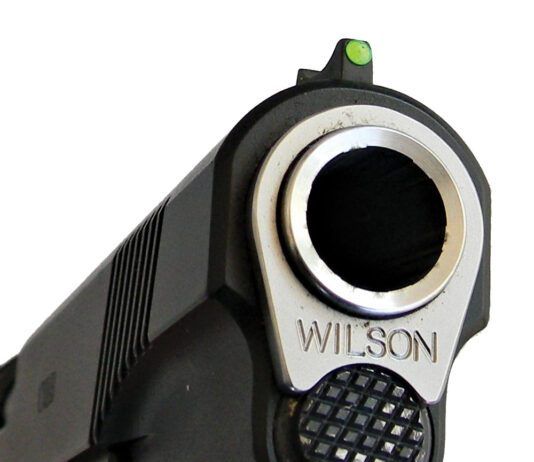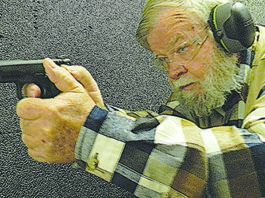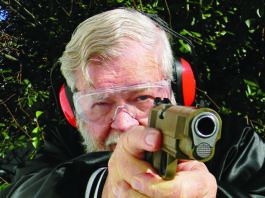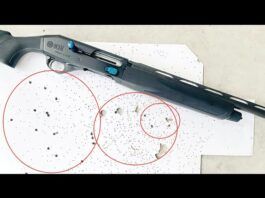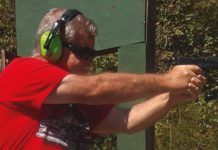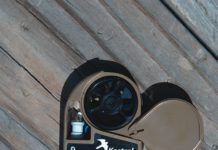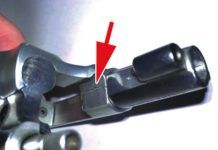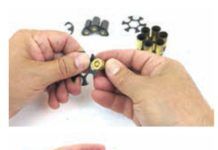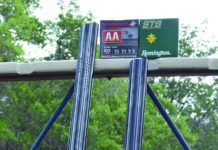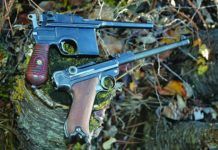Just Right Carbine Follow-Up
The first time we tested the Just Right Carbine in the June 2014 issue, we had beaucoup malfunctions and gave the rifle a D grade. Yet, the rifle seemed to have promise. Handling was good to excellent, the light-rail well designed, and compatibility with Glock magazines gave good utility. The accuracy test was a struggle due to malfunctions. But we did not have to go through hell and high water to get it working. We sent it back to the factory. When it returned, the JRC carbine was a different bird and sang a pretty tune. And we just may have learned a few things about pistol-caliber carbines in the second test. Make no mistake, it is best when the firearm works the first time, but the Just Right Carbine has potential. Heres what we thought after the follow-up test.
A Trio of Mako AR Accessories
The list of extras and "hop-up" parts for the AR-15 never seems to stop growing. Some of these parts are just for looks, but others do have a lot to offer. In the case of adjustable-length buttstocks, many are designed to improve cheek weld and offer a more secure, wobble-free locking system. We bought a pair of $122 FAB Defense Survival Buttstock GL-MAG units from TheMakoGroup.com to see what utility they might give us over a standard stock. We installed them on two different AR-15 carbines.
Promotional materials for the stocks said they provided a spare magazine well located immediately forward of the buttpad. The obvious advantage is that you can pick up the rifle and have an extra magazine in tow. In addition to extra rounds, a loaded magazine located in the buttstock provides ballast, allowing the operator to re-balance the rifle as he prefers.
The Survival Buttstock will stow any length or capacity AR-15 magazine (but not magazines for AR-10s).
The Survival Buttstocks arrived with 10-round magazines in place. The magazine-release buttons were located on the left side of the buttstocks.
We installed one stock on a carbine built to Mil-Spec standards and the other on a commercial-size tube. Installation was by standard procedure, simply slipping them on the buffer tube. The initial inlet of the Survival Buttstocks had some extra material that was not apparent when installing on the commercial-size AR-15. It glided smoothly into place, yet didn't wobble at all on the buffer tube. Getting the buttstock onto the buffer tube of our Mil-Spec AR-15 was more difficult. But a call to Mako's service rep assured us to go ahead and be more forceful. Once past the extra detent, the buttstock was secure and still moved easily forward and back.
Five-Shot 44-Cal Trail Guns from S&W, Taurus, and Charter Arms
A 22 LR revolver in single or double action can make an excellent trail gun—an inexpensive plinker and plenty of medicine for fisher cats, snakes, and squirrels for the pot. But once you start to hike in the woods and come across bear, wolf, or lion tracks, and the limitations of the 22 LR cartridge become real. Packing more power means a heavier caliber, which translates into a heavier pistol. That lightweight 22 LR may be easy to carry and pack into the back country, but what is required is a handgun that combines light weight with a powerful punch.
Our testers live in a very populated state with pockets of very rural territory where deer and coyote thrive. Occasional news reports of rabid coyotes are not uncommon on local TV. One spring, a black bear walked through the center of town looking for the ripest-smelling garbage can he could find. Even a mountain lion — unheard of this far east — was reported to be on the prowl. And then there are the two-legged predators. For all of these potential threats, some of our testers like 44 calibers, and Gun Tests reader e-mails seem to agree; in fact, we were asked to match up 44-caliber revolvers with 4-inch barrels that are light in weight and well suited for trail work. Add the lightweight criteria to a 44 caliber with a 4-inch barrel and that means a 5-shooter. We were specifically asked to test the Charter Arms Target Bulldog in 44 Special and the new S&W Model 69 in 44 Magnum. The new S&W actually has a 4.25-inch barrel. We also added into the 5-shot face off the Taurus 44 Tracker, which we have reviewed before and found to be a good choice and a useful baseline for comparing the other handguns.
Using a 44 revolver range rod (080-618-044WB, $25) from Brownells, we checked the alignment of the chambers to the barrel in all three new 5-shooters. We assumed they would be in spec and confirmed they were. Cylinder-gap gauges, also from Brownells (60/68 Cylinder Gauge, 080-633-668WB, $36), were used to check the headspace between the rear of the cylinder and the recoil plate. We also used feeler gauges from Brownells (606-950-252WB) to measure the gap between the front of the cylinder and the forcing cone of the barrel. Too close and the revolver will bind because of powder residue; too big a gap, and precious gas is siphoned off, reducing velocity. A gap of 0.003 inches is desirable. The Taurus was the tightest at 0.002 inches, followed by the S&W with 0.005 inches and the Charter Arms at 0.007 inches.
All three had firing pins built into the frame. The Taurus used a transfer bar between the hammer and firing pin while the Charter Arms and S&W used a hammer stop. For added safety, the Taurus and Smith & Wesson had a built-in lock to disable the revolver. A provided key allows the owner to lock and unlock these two guns.
Ammunition selections consisted of 44 Special and 44 Magnum fodder, both of which were used in the 44 Magnum-chambered revolvers. We knew the Charter Arms could not compete in the power category with the two other revolvers, but the 44 Special is a formidable caliber on its own, with a reputation for accuracy and quite a lot of punch. Old-school Remington 44 Special with a lead roundnose 246-grain bullet was used in all three revolvers. Hornady Critical Defense 44 Special loaded with 165-grain FTX bullets clocked close to 1000 fps out of the Target Bulldog. The Smith and Taurus were fed a steady diet of Sellier & Bellot and new Black Hills 44 Magnum ammunition, both loaded with 240-grain jacketed hollowpoints, a sweet-spot bullet weight for this caliber. During the range testing, we found the lightweight 44 Magnums were wrist crackers. Here's how they performed individually:
Tactical Models: Mossberg 930 Versus Remington 870 Pumpgun
In the scheme of things, the defensive shotgun is the problem solver for homeowners, ranchers, ship captains, zookeepers, and anyone in need of decisive stopping power. In personal defense, area defense, and defense against animals, the shotgun reigns supreme. Powerful, effective, and versatile, the 12-gauge shotgun is an awesome defensive tool. The question is often whether the self-loader is the better choice, particularly since most of us use self-loading handguns and rifles. In this test we put two well-known and popular brands, Remington and Mossberg, to the test. We fire a version of Big Green's most popular service-grade pump-action shotgun — the Remington 870 — against the Mossberg 930 self-loading shotgun.
There are important differences and similarities between the shotguns, other than the operating systems, self-loading and manual. Each featured plastic furniture and bead front sights. Each was drilled and tapped for an optical sight.
Both shotguns produced similar patterns with Federal, Remington, and Winchester 2-inch full-power 00 buckshot loads. There was no difference in the patterns worth mentioning when the guns were fired at 7, 10, and 15 yards. Reduced-recoil WinLite loads showed the best pattern at short range, as they often do, while Federal Magnums began to show an advantage at 15 yards. We also fired a limited number of slugs and learned that the Remington fired to the point of aim with Federal slugs at 10 yards.
The Remington was simple and rugged, but the 930 was also a capable and effective choice. In the end, a single feeding bobble separated the pair:
9mm Subcompact Shoot-out: Nano, LC9s, and the XD-S 3.3
Subcompact 9mm handguns are very popular carry guns, and in the past we have tested various 9mm compacts that are basically scaled-down service pistols, such as the Glock 26 and the Smith & Wesson Military & Police Compact. In contrast, the handguns covered in this report are 9mm subcompacts designed from inception as compact carry guns. Our test guns chambered in 9mm Luger were the Beretta BU9 Nano JMN9S15 9mm Luger, $369; the Ruger LC9s Standard 3235 9mm Luger, $339; and the Springfield Armory XD-S 3.3 XDS9339B, $494.
Our Beretta BU9 Nano JMN9S15 had an MSRP of $445, but we got ours at CheaperThanDirt.com for $369. At that MSRP, our black Nano, a pink version (JMN9S65), and a Flat Dark Earth-colored one (JMN9S55) are the least expensive pistols in the line, which includes state "compliant" models (JMN9S15FC, JMN9S65FC, JMN9S55FC) in the same colors, respectively, for $452. More expensive versions come with Crimson Trace lasers for MSRPs that start at $650.
Ruger's recently announced LC9s Pro (Model Number: 3248) has no external manual safety or magazine disconnect, making the original LC9s tested here the "Standard" model. Both have MSRPs of $449, but the price above reflects what Cheaper Than Dirt! was selling the gun for at the time of our test.
The XD-S pistols are the first single-stack polymer-framed versions from Springfield Armory. Our basic black XD-S 3.3 externally resembles the XD-S 45, which we tested in the December 2012 issue (Grade A). There's also a 9mm Bi-Tone 3.3-inch gun (XDS9339S) as well as 4-inch-barrel XD-S models.
When firing for accuracy at 15 yards, we used two loads from HPR, 115-grain jacketed hollowpoints ($28.13 for 50 rounds at CheaperThanDirt.com) and the HPR 124-grain XTP (also CheaperThanDirt.com, $26.65 for 50 rounds). We also used Black Hills TAC +P, which uses a Barnes 115-grain Tac-XP hollowpoint bullet, available from MidwayUSA.com for $25.20/50. We also handled the guns in more realistic tactical situations to assess their suitability for carry. Here's what we found:
Bushnell Elite Tactical XRS
Thanks to advancements in military technology, many innovative products are now available to the civilian buyer. We suspect that such products are a couple of generations behind what is actually in the hands of our elite soldiers, but in the case of the Bushnell Tactical Elite XRS riflescope ET45305ZA, with the Horus Vision TRMR2 H-59 reticle, the civilian may indeed have his hands on the cutting edge. The H-59 reticle offers precision mil-marking clusters interspersed throughout the reticle to enable fast accurate measurements at .1, .2, .5 and 1 mil increments, according to Bushnell literature. This enables the operator to quickly range targets and also correct for windage, elevation, and even movement without necessarily having to adjust the respective turrets manually.
In a recent discussion with high-level contractors, one trainer tasked with producing snipers and designated marksmen for the military said, Ive got squads using this very scope running through mock battles right now.
S&W Customer Service Report
Gear breaks, parts wear out. It is a fact with anything mechanical, and firearms are not immune. We can all relate to horror stories of trying to deal with a companys customer service to have our firearm repaired. Some companies just do not understand that a happy customer can be a lifelong customer and brand advocate. On the flip side, you have probably heard stories from a customer who had stellar customer service and cannot say enough good things about a company that went the extra mile to make them happy. Heres one of those stories.
We purchased a Smith & Wesson 642 Airweight 38 Special knowing the frame was cracked because we wanted to repair it and experience S&Ws customer service. We had one of our anonymous team members send the pistol so we would not get preferential treatment. Heres what happened. On December 26, our representative went to Smith-Wesson.com, and under the Resources panel, clicked Service for Contact Information. The website apologized in advance and asked for our patience and provided an email address. Not a good sign. We typed up a short note that read:
Three Generations of 45 ACP Revolvers from Smith & Wesson
Shooting the 45 ACP cartridge in a revolver may seem like an oxymoron, but the round has a long history of being matched up in revolvers starting at the turn of the 20th century. The issue in 1917, other than World War I, was a dearth of the new M1911 pistols as the U.S. became involved in the war. Tooling up for 1911 production was not an option since it would cost too much time. Remember, at the turn of the century, revolvers ruled the roost and all manufacturers were building double-action revolvers. With plenty of 45 ACP ammunition in inventory, the U.S. military turned to Colt and Smith & Wesson, which chambered the 45 ACP in their heavy frame revolvers.
S&W is credited with the idea of using moon clips, because there's a trick to firing the rimless 45 ACP cartridge in a wheelgun. Revolvers use rimmed cartridges, which headspace on the rim. Rimless pistol cartridges headspace on the case mouth. Insert a 45 ACP in the cylinder chamber and it will fit and probably fire the round. But the issue now becomes, how does the shooter eject the cartridge? The solution S&W came up with was a moon clip that holds six rounds, or a half-moon clip that holds three rounds. Both Colt and S&W used moon clips in what the U.S. Military named the United States Revolver, Caliber .45, M1917. We tested one of these old warhorses against two other generations of 45 ACP revolvers recently to see if the relic stood the test of time.
A newer generation is the S&W Champion Series Model 625-8 JM, with the JM standing for Jerry Miculek. This is the revolver that Mr. Miculek uses to shoot un-Godly fast; it took him 2.99 seconds to fire six shots, reload and fire six more shots with this model revolver. Testers really liked this revolver, though it seemed the plainest of the three revolvers, looking a lot like a Model 686. This revolver is very popular with IDPA shooters and other competitors. Now we know why — it loved to be run and run hard at the range.
The newest generation is the S&W Performance Center Model 325 Thunder Ranch, which is constructed from lightweight materials and offers a few modern updates on revolver design, which we thought were good intentions. But we learned we did not like having an accessory rail under the barrel. It's a good idea to incorporate a tactical light or laser sight onto a revolver via an accessory rail, but it's a bad idea to have the rail in a place that could potentially injure the shooter. More on that in a minute.
We looked at these N-frame revolvers through two lenses, one being defensive and the second being competitive. As testers pawed over the three revolvers, comments on the 45 ACP 6-shooters ranged from "novelty" and "antique" to "convenient" and "practical." The 1911 shooters leaned toward the positive end of the grading spectrum, while others seemed bothered to shoot a semi-automatic cartridge in a revolver. Nonetheless, we put the wheelguns through their paces, and here's how the generations fared.
Browning O/U 20 Gauges: New Model 725 Versus Veteran 325
Browning over-and-under shotguns have been a staple on the shooting market for longer than many veteran wingshooters would like to remember. In the simplest terms - they work. Naturally as time rolls on, innovations to help make the shotguns more user friendly, handle and perform better, and just make them more appealing to the eye are tossed into the mix. A good example is the transformation of Browning offerings in the Citori Model 25 line, as in 325, 425, 525, 625 and the current 725.
The latest smokepole to find its way into hands of hunters and target breakers is the Model 725 in 20 gauge that hit the market in 2014. The main new features to the subgauge over and under are internal — such as a mechanical trigger system, back-bored barrels with lengthened forcing cones, and the Invector-DS choke tube system introduced with the 12-gauge Model 725 a couple of years ago.
To see just how much the Citori had changed, we were able to obtain a Browning Model 325 20 gauge in very good shape. Last produced in the late 1990s, the Model 325 was the first in the line of X25s and has become quite scarce — their owners don't seem to be too anxious to part with them. The Model 325 we got our hands on had been in the gun safe of an acquaintance for quite some time, but was in excellent shape and provided a good example of how shotguns can change and still stay the same. The veteran 20 gauge featured 30-inch ported barrels and inertia triggers.
While the new Model 725 field version we used in the test carries a suggested retail price of $2470, the veteran used Model 325 in very good shape, if one can be found, is priced at about $1,500. We did not consider the price difference to be a major factor in our evaluation. As Gun Tests readers often point out, we'll talk about the guns, and the reader can decide if his budget can take the hit.
To check out the two 20-gauge shotguns in a variety of shooting situations, we selected the following test ammunition: On the target range and at the patterning board, we used Winchester AA Target 2.75-inch loads packing 7⁄8 ounce of No. 8 shot with an average muzzle velocity of 1200 fps, and Remington Premier STS Target 2.75-inch loads with 7⁄8 ounce of No. 8 shot with an average muzzle velocity of 1200 fps. For tests in the field, we used Federal Game 2.75-inch loads with 7⁄8 ounce of No. 7.5 shot with an average muzzle velocity of 1,210 fps. There were zero malfunctions with any of the loads in both of the test shotguns. Here are our findings:
9mms: Classic Artillery Luger Vs. 1896 Mauser Broomhandle
We were delighted to have this pair of rare and costly 9mm handguns to evaluate, thanks to a collector in Houston who sent them along with a bunch of fine accessories to our Idaho office. They were an Artillery Luger (about $2500) and an 1896 Mauser Broomhandle (about $2000), both with very good bores and in overall nice — though refinished — condition. Accessories for the Luger included a new wood stock, two eight-round magazines, a new 32-round drum magazine with loader and leather pouch, and a reproduction leather holster with a two-magazine pouch. The Broomhandle came in a new wood shoulder-stock/holster with leather, and a bunch of stripper clips.
Regarding the Artillery Luger, one must remember these guns are all very old. They were used a century ago in the First World War, this one having been made in 1915. They saw hard and heavy use and there are not a whole lot of them left. Those with pristine finishes command prices in the realm of $5000 on up, depending on condition and relative rarity of the individual gun. Thus, the price for this one is within reason for a good-looking representative sample with what we thought was an excellent barrel.
The Mauser looked at first to be pristine. However, we soon found out it had been refinished by a master who maintained all the markings and original surfaces very well indeed. There was some pitting here and there, such as under the grip areas and along the sides if you looked carefully, but whoever did the rework really knew his stuff. The subsequent bluing was probably done by hot-dip process, as there were none of the signs that accompany rust bluing. Nevertheless, the gun looked just great. Sadly, that was the only good part of this gun.
We tested them with two types of ammunition, 115-grain Independence FMJs and Black Hills 124-grain +P JHPs. Without further ado, here's what we found.
(Gunsmithing the AR-15 #1) Lubrication and the AR-15/M-16
The subject of lubrication is vast, and opinions vary. In most situations, as one of the instructors has been know to joke, "sunscreen would probably work for a while." Adherents of one or another brand of lubricant will extol its virtues endlessly. Whatever you use, use it. A dry AR is a rifle looking to malfunction. Invariably in the patrol rifle and patrol rifle instructor classes taught in NEMRT, we have rifles whose owners thought they had sufficiently lubed them start to malfunction right after lunch of the first full firing day. You don't want so much lube on it that it splatters you and bystanders on every shot. But if, when you touch the carrier through the ejection port, you don't get oil on your fingertip, the carrier (and thus the bolt) is probably too dry. Some have suggested that the best way to keep an AR-15 or M-16 running reliably is to keep it dry, to prevent it from attracting dirt. They are wrong. You need oil to reduce friction, and carry grit and dirt away from the working parts. Running a rifle while it is dry will simply make it malfunction sooner, not later.
(Gunsmithing the AR-15 #2) The 30-Second AR Check
From nationally known 1911 custom gunsmith Ned Christiansen, who is also a stellar AR-15 ‘smith and operator:
"They're almost upon us, grab one of these rifles and get ready": the 30-second prioritized AR15 checklist. Items are prioritized factoring in criticality, ease of checking, sequence and likelihood.
If you have a half a minute, you can confirm that:


























